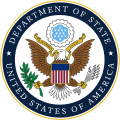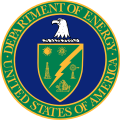Overview
Structure
Each department is headed by a secretary whose title echoes the title of their respective department, with the exception of the Department of Justice, whose head is known as the attorney general. The heads of the executive departments are appointed by the president and take office after confirmation by the United States Senate, and serve at the pleasure of the president. The heads of departments are members of the Cabinet of the United States, an executive organ that normally acts as an advisory body to the president. In the Opinion Clause (Article II, section 2, clause 1) of the U.S. Constitution, heads of executive departments are referred to as "principal Officer in each of the executive Departments".
The heads of executive departments are included in the line of succession to the president, in the event of a vacancy in the presidency, after the vice president, the speaker of the House, and the president pro tempore of the Senate. They are included in order of their respective department's formation, with the exception of the secretary of defense, whose position in the line of succession is based on when the Department of War was formed.
Separation of powers
To enforce a strong separation of powers, the federal Constitution's Ineligibility Clause expressly prohibits executive branch employees (including heads of executive departments) from simultaneously serving in Congress, and vice versa. Accordingly, in sharp contrast to parliamentary systems where ministers are often selected to form a government from members of parliament, [2] U.S. legislators who are appointed by the president and confirmed by the Senate to serve as heads of executive departments must resign from Congress before assuming their new positions. [3] If the emoluments for a new appointee's executive branch position were increased while the appointee was previously serving in Congress (e.g., cost of living adjustments), the president must implement a Saxbe fix. [4]
Contracting and grantmaking roles
The chart below shows that several executive departments (Education, Health and Human Services, Housing and Urban Development, and Transportation) have disproportionately small employee headcounts in contrast to the size of their budgets. This is because many of their employees merely supervise contracts with private independent contractors or grants (especially categorical grants) to state or local government agencies who are primarily responsible for providing services directly to the general public. In the 20th century, when the federal government began to provide funding and supervision for matters which were historically seen as the domain of state governments (i.e., education, health and welfare services, housing, and transportation), Congress frequently authorized only funding for grants which were voluntary, in the sense that state or local government agencies could choose to apply for such grants (and accept conditions attached by Congress) or they could decline to apply. [5] In the case of HHS's Medicare program, Congress chose to contract with private health insurers because they "already possessed the requisite expertise for administering complex health insurance programs", and because American hospitals preferred to continue dealing with private insurers instead of a new federal bureaucracy. [6]
This page is based on this
Wikipedia article Text is available under the
CC BY-SA 4.0 license; additional terms may apply.
Images, videos and audio are available under their respective licenses.



















